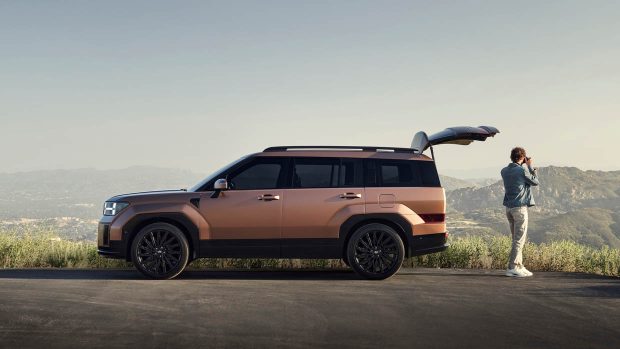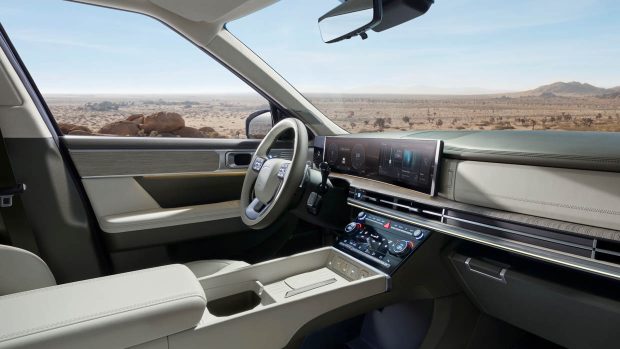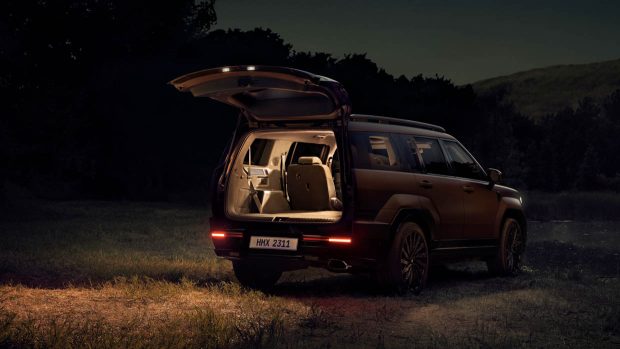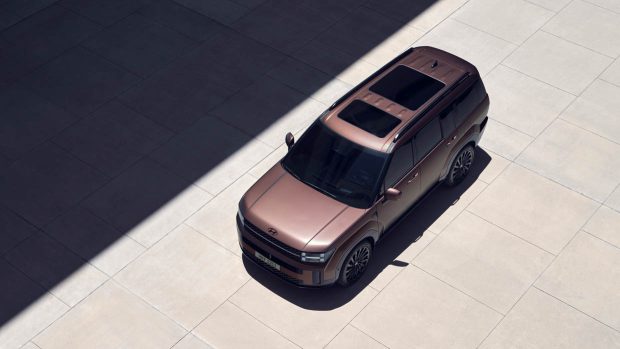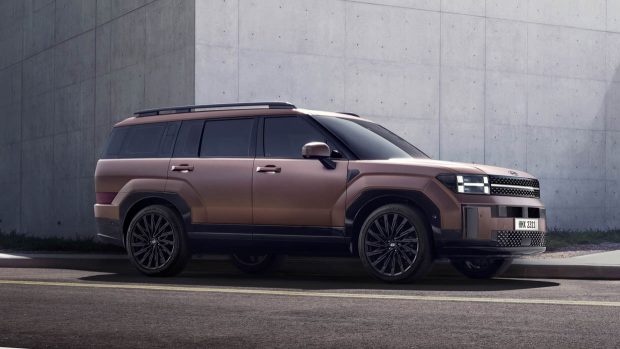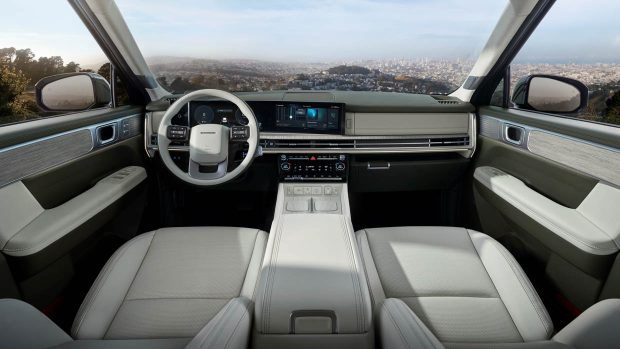-
Car Reviews
- All reviews
- Midsize SUVs
- Small cars
- Utes
- Small SUVs
- Large SUVs
- Large cars
- Sports SUVs
- Sports cars
- Vans
Latest reviews
- Car News
-
Car Comparisons
Latest comparisons
- Chasing Deals
Bigger, more powerful and more efficient Santa Fe coming to Australia next year
Hyundai has released more details of its all-new Santa Fe large SUV following its global reveal in July this year, confirming suspicions that enlarged overall dimensions, more powerful drivetrains and improved efficiency would accompany the radical design departure.
Growing in all directions except width, the new Santa Fe is now more spacious inside with a deliberate focus on maximising the versatility of the load area for those with outdoor and adventurous lifestyles as well as suburban duties, says Hyundai.
Petrol-only powertrains bring higher performance but lower fuel use, while the arrival of new safety and comfort technology matches the new model’s futuristic design.
Exact details regarding which of the comprehensive revisions will be coming to Australia are yet to be detailed ahead of the model’s arrival before July 2024.
The new Santa Fe’s long list of upgrades will be used to take on the large SUV segment, occupied by rivals such as the Toyota Kluger, Kia Sorento and Nissan Pathfinder.
Now measuring 4830mm long and 1720mm high, the fifth-generation Santa Fe has grown by 45mm in length and is 35mm taller, while its width remains unchanged at 1900mm. Its wheelbase has undergone the biggest stretch from 2765mm to 2815mm – longer by 50mm.
This has resulted in more space almost everywhere. Second-row legroom is up as much as 35mm while, as the Santa Fe continues on as a seven-seater, third-row legroom has increased by another 15mm.
The good news continues for passengers in the back stalls with nearly 70mm more headroom, a 30mm-boosted seat height also benefits under-thigh support, while the seating now reclines 10-degrees further for more comfort.
At the very back, the Santa Fe’s boot grows to an impressive 725 litres with the third row of seating folded away, representing 91 extra litres compared with the fourth-gen model. Fold all the rear seats and the boot increases to 1275L – 145L more than before.
Loading the larger cargo area is also easier thanks in-part to a wider tailgate, while a new handle concealed in the C-pillar enables easier loading of items on the roof.
Four new powertrains will be available for the new model depending on the global market.
Native South Korea and North America will get a turbocharged 2.5-litre four-cylinder petrol with 207kW and 422Nm paired with eight-speed dual-clutch auto, while Europe will be exclusively treated to a plug-in hybrid version with a 1.6-litre turbo four-cylinder petrol and outputs of 118kW and 265Nm with six-speed auto.
Both regions will share a third mild hybrid version which uses the same 1.6-litre engine and six-speed automatic transmission to produce combined outputs of 132kW/265NM, albeit minus the PHEVs electric-only option.
A fourth powertrain completes the engine line-up at the entry level with a naturally aspirated version of the 2.5-litre four-cylinder petrol paired with eight-speed torque-converter type auto, although Hyundai is yet to confirm to which global markets it’ll be offered.
As expected, there’s no fully electric Santa Fe, leaving the stage free for the incoming Ioniq 7 and mechanically related Kia EV9. More surprising is the lack of diesel powertrains across the board.
Exactly which of the engine and transmission combinations (if not all) will be coming to Australia has not yet been made public, but the smart money would be on the turbocharged 2.5 and mild hybrid versions.
If so, the Theta III 2.5 T-GDI will outgun the existing 3.5-litre V6 petrol by 7kW and 91Nm but uses less fuel to the tune of 1.5 litres per 100km.
Performance numbers remain the same for the 1.6-litre mild hybrid version at 132kW/265Nm, which is available in Australia with the current-gen version, although fuel consumption in this case has increased from 6.0L/100km to 6.5L/100km for the new model.
This is most likely the product of increased kerb weight which has swelled by 242kg to 2225kg, while the 2155kg 2.5T weighs 297kg more than the V6 it replaces.
A host of new technology completes the generational transformation including a special tray that sterilises smartphones with UV light while up to two devices charge wirelessly, and Hyundai’s first Panoramic Curved Display which blends 12.3-inch information screen with fully digital driver’s instrument cluster.
There’s a Relaxation Seat in the front row that fully reclines for a feeling of ‘weightlessness’ says Hyundai, 6.6-inch digital climate control touchscreen, a six-seat option which replaces the three seat bench with two more luxurious chairs, and Digital Key 2 which ditches the regular fob in favour of a smartphone application.
Safety has also been given a top-down revision with navigation-based adaptive cruise control, more sophisticated driver attention monitoring which can read the driver’s vital signs, and Hyundai’s most advanced AEB with forward collision avoidance and lane follow assistance.
The current-generation Hyundai Santa Fe is available in four levels of specification with three powertrain options. Hyundai is yet to reveal how the new range will compare in specification and pricing.
Latest news
About Chasing cars
Chasing Cars reviews are 100% independent.
Because we are powered by Budget Direct Insurance, we don’t receive advertising or sales revenue from car manufacturers.
We’re truly independent – giving you Australia’s best car reviews.
